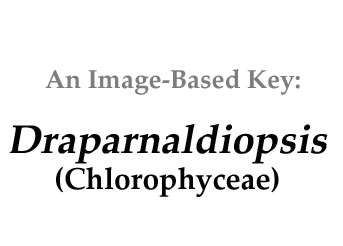|
Home / Greens / Filamentous / Branched / Draparnaldiopsis
|
||||
|
|
||||
|
Click
on images for larger format |
||||
Name derivation: |
||||
Classification: |
||||
Draparnaldiopsis G.M.Smith & Klyver, 1929; 8 of 9 species descripsions are currently accepted taxonomically (Guiry and Guiry 2014).
Order Chaetophorales; Family Chaetophoraceae
|
||||
Morphology: |
||||
Consisting of branched,
filaments. Main axes of cylindrical
cells of different length, short cells alternating with longer cells. Contains secondary branches that are short and alternate from one
another. Cells of secondary branches cylindrical, inflated or fusiform, with terminal cells narrowly obtuse or bearing
long multicellular hairs.(Smith
1902). Cells uninucleated.
Reproduction by zoospores often produced in cells of main axes and
gametes in those of secondary branches
|
||||
|
||||
|
Draparnaldia has uniform length of cylindrical cells in main axis. |
||||
Habitat: |
||||
|
|
||||
|
Citing Phycokey: |
||||
|
Baker,
A.L. et al. Phycokey
-- an image based key to Algae (PS Protista),
Cyanobacteria, and other aquatic objects. University of New Hampshire Center
for Freshwater Biology. http://cfb.unh.edu/phycokey/phycokey.htm. |
||||
References: |
||||
|
Smith, G.M. & Klyver, F.D. (1929). Draparnaldiopsis,
a new member of the algal family Chaetophoraceae.
Transactions of the American Microscopical Society
48: 196-203, 1 pl. |
||||

